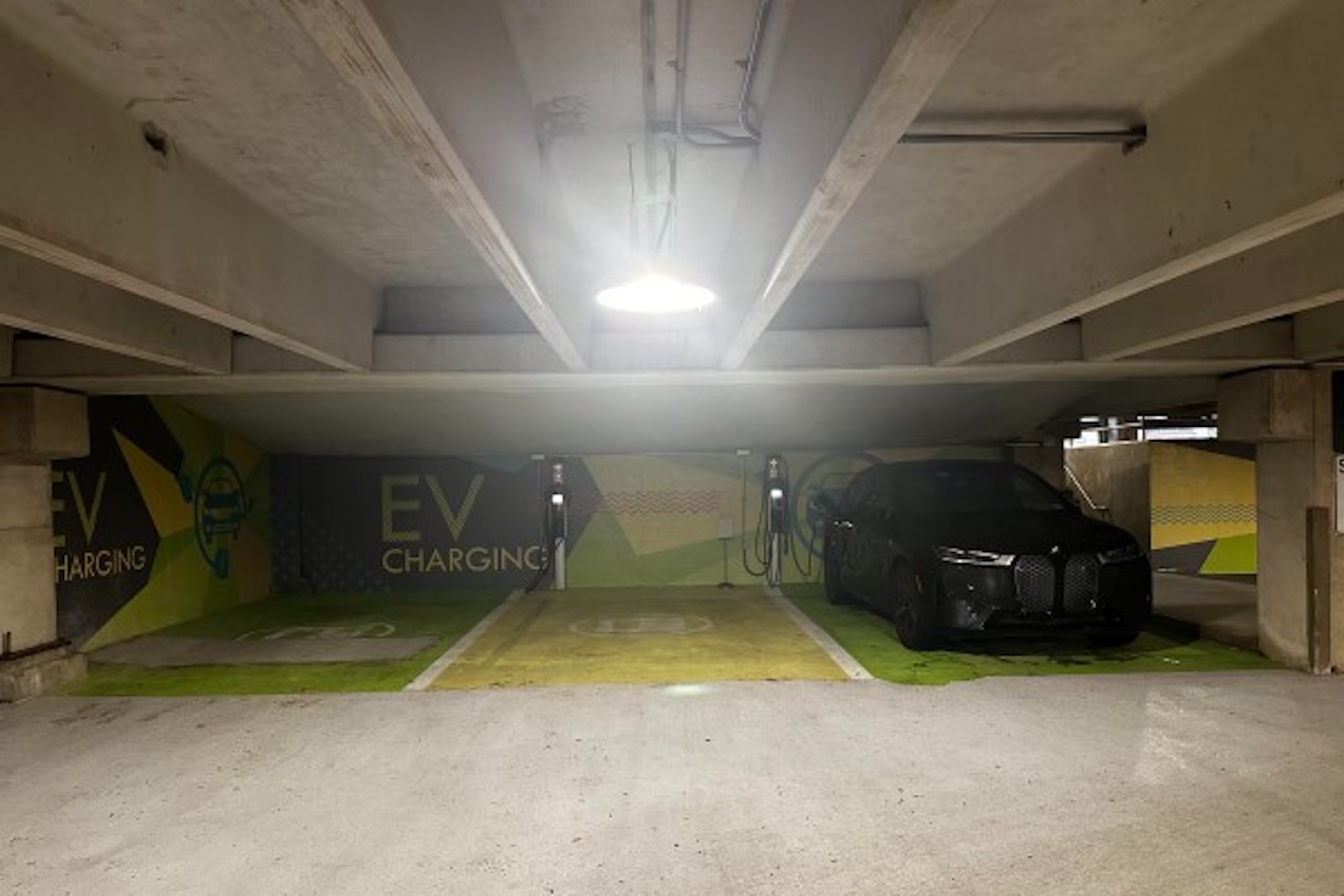As the EV industry has grown, a number of players have tried to address the lack of available EV charging at multi-unit dwellings. With 44 million renter households in the U.S., the ability to conveniently charge at an apartment building is critical if EVs are to become mainstream.
However, installing charging at multi-unit buildings is still challenging. “The ideal outcome is for each unit in a multi-unit dwelling to have access to a dedicated EV charger,” Noelani Derrickson from Tesla told me in a recent article.
Orange, a California-based startup, says it has the right solution for this challenge.
The problem
Both tenants and building owners of multi-unit dwellings have their own set of problems with EV charging.
The tenant’s concerns:
- Unless the tenant is lucky enough to have charging at their parking spot, they have to share a Level 2 charger, which means they have to move their vehicle every time.
- If the parking garage is underground, the tenant might not be able to use a Level 2 charging station if they don’t have a cell phone signal and can’t access the building’s Wi-Fi.
The building owner’s concerns:
- Installing standard 120-volt outlets at tenant parking spots and charging a flat fee for charging isn’t a scalable solution; unmanaged charging isn’t economical as utility bills will add up, and it offers less-than-ideal charging speeds to the tenant.
- Installing Level 2 chargers through an EV charging company at tenant parking spots consumes a lot of space and can be costly if the tenants don’t use them frequently.
- Installing Level 2 chargers for shared use causes congestion as demand grows, requiring that tenants move their vehicles after charging is complete.

![]()
![]()
![]()
![]()
![]()
![]()
![]()
![]()
![]()
![]()
![]()
![]()
![]()
Orange’s Outlet solution
Among Orange’s charging solutions, the Orange Outlet 620 stands out to me.
“There is a huge demographic of people who live in apartments; you have necessity and lifestyle apartments,” said Nicholas Johnson, Orange’s CEO. “We never wanted EVs to be just for rich people, and so the Outlet was really a solution to the problem statement [a lack of charging in apartments].”
The Outlet hits on three key elements that make it a good option for building owners and tenants.
Smart features in a simple package
Every Outlet has an energy watt-hour meter, allowing the building owner to understand how much energy each tenant consumes and bill them accordingly. Additionally, the Outlets run off a local network and a Bluetooth mesh system between themselves and the tenant’s phone. Once the tenant downloads the app, they can initiate charging even if their phone lacks a cell signal or Wi-Fi access.
“We built a push-pull architecture, so the Outlets operate offline through what we call the Orange net,” Johnson said. “All our Outlets have the ability to build their own networks, they have their own cell modems, and they have Bluetooth, so they communicate locally with the cell phone.”
Level 2 charging speeds
The Outlet 620 is a refreshing reminder that going back to the basics is often important.
It looks like a standard outlet that you could find anywhere aside from its bright orange color and QR code. It even costs the same to Orange to manufacture and install as the Orange Outlet 520, its Level 1 charger. But it charges a vehicle at Level 2 speeds, offering tenants 15 mph of charging at 16 amps continuous current.
The tenant can plug in the charging cable that comes with their vehicle. Essentially, the Outlet brings single-family-home charging convenience to apartment dwellers in a small and simple package.
Economical to install
The Outlet’s impact potential fits within its economics. For example, Orange has installed 125 outlets at two separate California properties. That scale is pretty exciting because Outlet enables each parking spot to have its own charger. But the economics need to work out, and based on Orange’s calculations, they do.
Orange estimates saving building owners more than 70 percent by purchasing and installing the Outlet compared with a standard Level 2 charger. According to Orange, one of the biggest areas of savings is electrical and installation costs. In addition, Orange’s hardware costs $400 compared with other Level 2 chargers, which cost $2,000 or more, according to an estimate on the company’s website.
Johnson walked me through a price simulator where I asked him to show me the price of installing 10 Outlets in California compared with other providers, and the unit economics were obvious.
“We built this solution [the Outlet] from Day One to work without incentives,” Johnson said. “If we install 10 chargers, that’s around $22,000, and if you do the same thing with another Level 2 solution provider, you’re looking at $100,000 out of pocket, and that delta is huge.”
One reason for this price difference is in the less sexy side of EV charging. Orange runs smaller gauge wires for the power. “It’s like having a Level 1 plug but with Level 2 power,” Johnson said. “By doing a 20-amp 240-volt, we use the same gauge wire as a Level 1 circuit, but we get three times the charge rate … so we can install more chargers with the same panel capacity.”
As the EV market evolves, one thing is clear — new players such as Orange are rethinking what is necessary for the customer and the industry overall.
- SEO Powered Content & PR Distribution. Get Amplified Today.
- PlatoData.Network Vertical Generative Ai. Empower Yourself. Access Here.
- PlatoAiStream. Web3 Intelligence. Knowledge Amplified. Access Here.
- PlatoESG. Carbon, CleanTech, Energy, Environment, Solar, Waste Management. Access Here.
- PlatoHealth. Biotech and Clinical Trials Intelligence. Access Here.
- Source: https://www.greenbiz.com/article/solving-ev-charging-problem-multi-unit-dwellings
- :has
- :is
- :not
- :where
- $UP
- 000
- 1
- 10
- 125
- 15%
- 16
- 7
- a
- ability
- Able
- access
- According
- accordingly
- add
- addition
- Additionally
- address
- After
- All
- Allowing
- AMPs
- an
- analysis
- and
- Another
- anywhere
- Apartment
- apartments
- app
- architecture
- ARE
- areas
- around
- AS
- aside
- At
- available
- back
- based
- Basics
- BE
- because
- become
- between
- Biggest
- Bill
- Bills
- bluetooth
- Bright
- Brings
- build
- Building
- built
- but
- by
- cable
- california
- call
- CAN
- Capacity
- causes
- cell
- ceo
- challenge
- challenging
- charge
- charges
- charging
- clear
- click
- code
- color
- comes
- communicate
- company
- Company’s
- compared
- complete
- Concerns
- congestion
- continuous
- convenience
- conveniently
- Cost
- costly
- Costs
- could
- critical
- Current
- customer
- data
- day
- dedicated
- Delta
- Demand
- demographic
- difference
- do
- doing
- Dont
- downloads
- each
- Economics
- Electric
- electric vehicle
- elements
- enables
- energy
- enough
- essentially
- estimate
- estimates
- Ether (ETH)
- EV
- Even
- Every
- evolves
- evs
- example
- exciting
- Features
- fee
- Find
- flat
- For
- Free
- frequently
- from
- garage
- gauge
- get
- going
- good
- great
- grown
- Grows
- Hardware
- harvard
- Have
- having
- him
- Hits
- How
- HTTPS
- huge
- i
- ideal
- if
- Impact
- important
- in
- Incentives
- industry
- initiate
- install
- installation
- installing
- IT
- ITS
- Johnson
- jpg
- just
- Key
- Lack
- less
- Level
- lifestyle
- like
- live
- local
- locally
- looking
- LOOKS
- Lot
- Mainstream
- make
- Market
- me
- means
- mesh
- might
- million
- more
- move
- much
- necessary
- necessity
- Need
- net
- network
- networks
- never
- New
- Newsletter
- nicholas
- node
- number
- obvious
- of
- off
- offering
- Offers
- offline
- often
- on
- once
- ONE
- operate
- Option
- or
- Orange
- Other
- our
- out
- Outcome
- outlet
- Outlets
- overall
- own
- owner
- owners
- package
- panel
- parking
- People
- phone
- plato
- Plato Data Intelligence
- PlatoData
- players
- plug
- potential
- power
- presentation
- pretty
- price
- Problem
- problems
- properties
- provider
- providers
- purchasing
- QR code
- Rate
- really
- reason
- recent
- reminder
- Rich
- right
- Run
- runs
- s
- Said
- same
- saving
- Savings
- says
- scalable
- Scale
- separate
- set
- Share
- shared
- show
- side
- sign
- Signal
- Simple
- simulator
- small
- smaller
- So
- solution
- Solutions
- Solving
- Space
- speeds
- Spot
- spots
- standard
- stands
- startup
- Statement
- station
- Still
- such
- sustainable
- system
- tenant
- Tesla
- than
- that
- The
- The Basics
- their
- Them
- themselves
- There.
- they
- thing
- this
- three
- Through
- time
- times
- to
- told
- transport
- tried
- two
- u.s.
- understand
- unit
- unit economics
- use
- utility
- vehicle
- Vehicles
- walked
- want
- wanted
- was
- we
- were
- What
- What is
- which
- WHO
- Wi-fi
- will
- Wire
- with
- within
- without
- Work
- work out
- you
- zephyrnet









